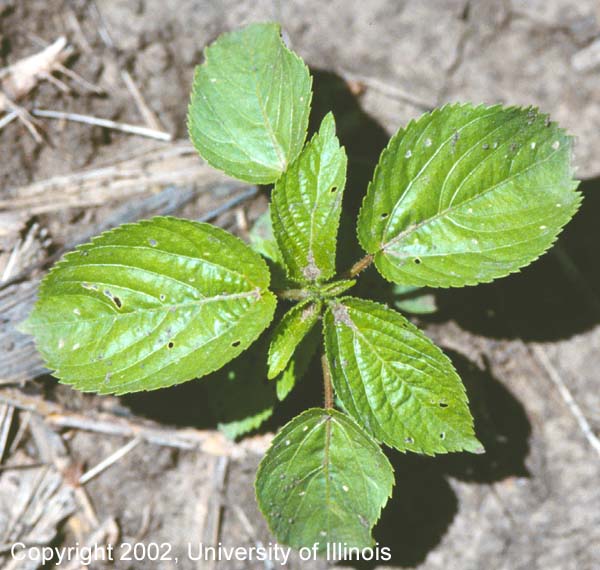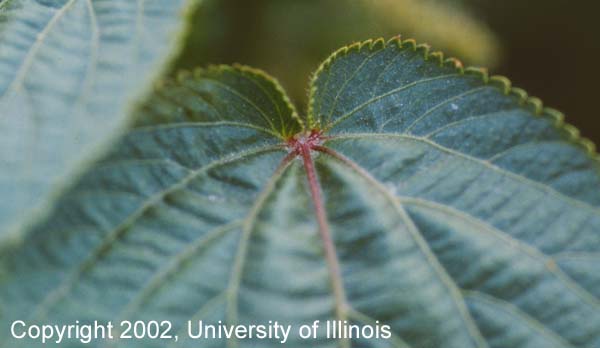|
|
Hophornbeam
copperleaf
Acalypha ostryifolia L.
Background
Hophornbeam copperleaf is a summer annual species and
a member of the Euphorbiaceae (spurge) plant family.
Many members of this family have a milky sap that exudes
from the plant when injured, but hophornbeam copperleaf
does not. This plant is native to the United States
and can be found in fields, gardens, and wasteland areas
stretching from New Jersey to Kansas and south to Florida
and Texas. It may also be referred to as three-seeded
mercury.
Description
Hophornbeam copperleaf has round, pubescent cotyledons
and true leaves with short hairs and serrated margins.
Leaves are simple and alternate. A red coloration may
be noticeable where the main leaf veins intersect the
petiole. Plants can grow to be approximately 75-100
cm tall. |

Figure
1. Hophornbeam copperleaf seedling
|
| 
Figure
2. Red coloration near petiole
|
Hophornbeam
copperleaf is commonly misidentified as prickly sida
(Sida spinosa). Prickly sida, however, has coarser larger
leaf serrations and stipules (spines) in the leaf axils.
Hophornbeam copperleaf is monoecious (male and female
flowers on the same plant). The male flowers are produced
on axillary spikes, while the female flowers are produced
on a long terminal spike. Capsules will split open when
mature to release the seed. Previous research has reported
that hophornbeam copperleaf produced 12,500 seeds when
grown without competition, but seed production was greatly
reduced (1000 seeds) when grown in competition with
soybean. Seeds are about 0.2 cm in diameter, shaped
like a raindrop, and have a wrinkled appearance.
Emergence of hophornbeam copperleaf begins in late
May or early June, and may continue after each rainfall
event throughout much of the growing season. Germination
appears to be based on temperature which may explain
the late flushes that occur.
|
Management
The late- season emergence pattern allows hophornbeam
copperleaf to escape many control measures. Dinitroaniline
(DNA) herbicides such as Prowl and Treflan offer no
control, while many acetolactate synthase- (ALS) inhibiting
herbicides provide inconsistent control.
Control in soybean can be attained by the use of a
soil-applied herbicide containing sulfentrazone, flumioxazin,
metribuzin, or cloransulam. These soil-applied herbicides
should be applied no earlier than two weeks before planting.
Postemergence soybean herbicides containing aciflurofen,
lactofen, fomesafen, or glyphosate provide good control
of hophornbeam copperleaf. These herbicides should be
applied before plants reach 10-15 cm in height for optimum
control.
|
 Figure 3. Seed
Figure 3. Seed |
| A
study at Oklahoma State University in 1971 found atrazine
to be effective in controlling hophornbeam copperleaf.
However, current application timing and rate restrictions
may not allow atrazine to keep this weed in check. Mesotrione
and pyridate in combination with atrazine provide adequate
control of hophornbeam copperleaf when applied before
plants reach 5 cm in height. Cultivation would also
be beneficial.
Shade provided
by a crop canopy can help suppress growth of hophornbeam
copperleaf. Uniform crop stands and narrow row spacings
decrease the amount of sunlight available to hophornbeam
copperleaf. Producers should be aware that as the crop
begins to mature and more sunlight reaches the soil
surface, additional emergence of hophornbeam copperleaf
may occur.
|
|
|
|

